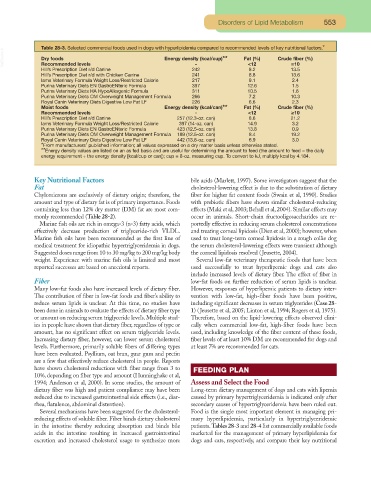Page 535 - Small Animal Clinical Nutrition 5th Edition
P. 535
Disorders of Lipid Metabolism 553
Table 28-3. Selected commercial foods used in dogs with hyperlipidemia compared to recommended levels of key nutritional factors.*
VetBooks.ir Dry foods Energy density (kcal/cup)** Fat (%) Crude fiber (%)
Recommended levels
-
≥10
Hill’s Prescription Diet r/d Canine 242 <12 13.5
8.2
Hill’s Prescription Diet r/d with Chicken Canine 241 8.8 13.6
Iams Veterinary Formula Weight Loss/Restricted Calorie 217 9.1 2.4
Purina Veterinary Diets EN GastroENteric Formula 397 12.6 1.5
Purina Veterinary Diets HA HypoAllergenic Formula 311 10.5 1.6
Purina Veterinary Diets OM Overweight Management Formula 266 7.2 10.3
Royal Canin Veterinary Diets Digestive Low Fat LF 226 6.6 2.3
Moist foods Energy density (kcal/can)** Fat (%) Crude fiber (%)
Recommended levels - <12 ≥10
Hill’s Prescription Diet r/d Canine 257 (12.3-oz. can) 8.6 21.2
Iams Veterinary Formula Weight Loss/Restricted Calorie 397 (14-oz. can) 14.9 3.2
Purina Veterinary Diets EN GastroENteric Formula 423 (12.5-oz. can) 13.8 0.9
Purina Veterinary Diets OM Overweight Management Formula 189 (12.5-oz. can) 8.4 19.2
Royal Canin Veterinary Diets Digestive Low Fat LF 442 (13.6-oz. can) 6.9 3.0
*From manufacturers’ published information; all values expressed on a dry matter basis unless otherwise stated.
**Energy density values are listed on an as fed basis and are useful for determining the amount to feed (the amount to feed = the daily
energy requirement ÷ the energy density [kcal/cup or can]); cup = 8-oz. measuring cup. To convert to kJ, multiply kcal by 4.184.
Key Nutritional Factors bile acids (Marlett, 1997). Some investigators suggest that the
Fat cholesterol-lowering effect is due to the substitution of dietary
Chylomicrons are exclusively of dietary origin; therefore, the fiber for higher fat content foods (Swain et al, 1990). Studies
amount and type of dietary fat is of primary importance. Foods with prebiotic fibers have shown similar cholesterol-reducing
containing less than 12% dry matter (DM) fat are most com- effects (Maki et al, 2003; Behall et al, 2004). Similar effects may
monly recommended (Table 28-2). occur in animals. Short-chain fructooligosaccharides are re-
Marine fish oils are rich in omega-3 (n-3) fatty acids, which portedly effective in reducing serum cholesterol concentrations
effectively decrease production of triglyceride-rich VLDL. and treating corneal lipidosis (Diez et al, 2000); however, when
Marine fish oils have been recommended as the first line of used to treat long-term corneal lipidosis in a rough collie dog
medical treatment for idiopathic hypertriglyceridemia in dogs. the serum cholesterol-lowering effects were transient although
Suggested doses range from 10 to 30 mg/kg to 200 mg/kg body the corneal lipidosis resolved (Jeusette, 2004).
weight. Experience with marine fish oils is limited and most Several low-fat veterinary therapeutic foods that have been
reported successes are based on anecdotal reports. used successfully to treat hyperlipemic dogs and cats also
include increased levels of dietary fiber. The effect of fiber in
Fiber low-fat foods on further reduction of serum lipids is unclear.
Many low-fat foods also have increased levels of dietary fiber. However, responses of hyperlipemic patients to dietary inter-
The contribution of fiber in low-fat foods and fiber’s ability to vention with low-fat, high-fiber foods have been positive,
reduce serum lipids is unclear. At this time, no studies have including significant decreases in serum triglycerides (Case 28-
been done in animals to evaluate the effects of dietary fiber type 1) (Jeusette et al, 2005; Linton et al, 1994; Rogers et al, 1975).
or amount on reducing serum triglyceride levels. Multiple stud- Therefore, based on the lipid-lowering effects observed clini-
ies in people have shown that dietary fiber, regardless of type or cally when commercial low-fat, high-fiber foods have been
amount, has no significant effect on serum triglyceride levels. used, including knowledge of the fiber content of these foods,
Increasing dietary fiber, however, can lower serum cholesterol fiber levels of at least 10% DM are recommended for dogs and
levels. Furthermore, primarily soluble fibers of differing types at least 7% are recommended for cats.
have been evaluated. Psyllium, oat bran, guar gum and pectin
are a few that effectively reduce cholesterol in people. Reports
have shown cholesterol reductions with fiber range from 3 to FEEDING PLAN
10%, depending on fiber type and amount (Hunninghake et al,
1994; Anderson et al, 2000). In some studies, the amount of Assess and Select the Food
dietary fiber was high and patient compliance may have been Long-term dietary management of dogs and cats with lipemia
reduced due to increased gastrointestinal side effects (i.e., diar- caused by primary hypertriglyceridemia is indicated only after
rhea, flatulence, abdominal distention). secondary causes of hypertriglyceridemia have been ruled out.
Several mechanisms have been suggested for the cholesterol- Food is the single most important element in managing pri-
reducing effects of soluble fiber. Fiber binds dietary cholesterol mary hyperlipidemia, particularly in hypertriglyceridemic
in the intestine thereby reducing absorption and binds bile patients. Tables 28-3 and 28-4 list commercially available foods
acids in the intestine resulting in increased gastrointestinal marketed for the management of primary hyperlipidemia for
excretion and increased cholesterol usage to synthesize more dogs and cats, respectively, and compare their key nutritional

